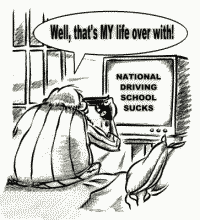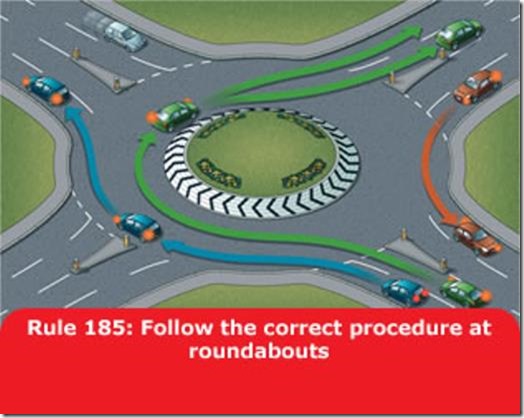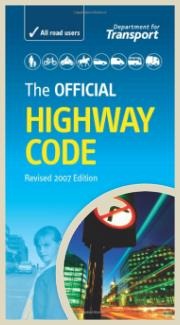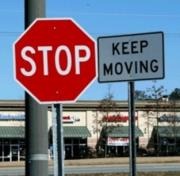I just saw a skit on BBC Breakfast about teaching young drivers – as young as 11 – to drive. It is an initiative which is being championed by Quentin Willson (yes, two “ells”; media motoring “expert”).
In the skit, an in-car camera recorded an 11-year old with a huge grin exclaiming:
How cool is this?
…as he drove a car around an off-road circuit.  Just remember that, because I will. That 11-year old was driving a car and exclaimed:
Just remember that, because I will. That 11-year old was driving a car and exclaimed:
“HOW COOL IS THIS?”
It doesn’t take a huge leap of the imagination to transport him – or someone his age – from a private compound near to London to an inner city street with a gang of his mates, taking a car that doesn’t belong to him. Or on a Road Wars video, trying to evade the police as they try and catch him.
I’ve known about this scheme for some time. To be honest, I have always known it for what it is – a brilliantly clever way of selling driving lessons at almost £60 an hour! That’s around three times the normal cost of an hour’s lesson.
In that respect, I have no axe to grind with the scheme. It’s a business ploy to sell driving lessons at a ridiculously inflated price, but it is still a fantastic Unique Selling Point (USP). In fact, it’s quite similar to Mercedes Benz’s idea of selling expensive lessons in expensive cars to Hooray Henrys and Henriettas (or their provincial counterparts) in terms of its business model.
However, Willson and that 11-year old have now taken it to the next level for me. The next level downwards. You see, Willson has spoken in Parliament on this topic. He says (indeed, has said – in front of Parliament):
I passionately believe that we don’t teach young drivers to actually drive, only to pass a test, and one that’s woefully inadequate.
This is complete bollocks, and Willson ought to understand what he is talking about before shooting his mouth or, or committing himself to it so “passionately” (the same goes for driving instructors who embrace this scheme merely because it is aimed at children). Passion is often a mask for blindness and ignorance. I’m also fairly certain Willson has some links with the school mentioned, because I read somewhere else that his own son had taken lessons with them. To that end, he adds:
One of the most important things this Committee could do is to consider a revolutionary new young driver programme where driving is part of the school syllabus, much like citizenship. Teaching kids to drive at 17 is at their least receptive age. Their mindsets are already corrupted and corroded by video games like Grand Theft Auto and the worst excesses of Top Gear.
Seeing as he is a former presenter of Top Gear, is he not guilty of peddling “excesses” to the teenage masses out there for his own profit? Does he not do that now in the Sunday newspapers, as he drools over the latest supercars that less than 1% of the population could ever afford?
What does this misguided individual think will happen when kids’ minds have been filled with the desire to drive a car (and the impression that getting one is only just around the corner), AND THEN get “corrupted” by Grand Theft Auto and the “excesses” of Top Gear? Basically, you’ll be teaching them how to drive the cars they will end up nicking – and increasing the likelihood of the theft in the first place by creating a desire!
Can he not realise that a juvenile mind is a juvenile mind. In the entire recorded history of the world – and into pre-history – a juvenile has been a juvenile, requiring nurturing and protection on the way to adulthood, making reckless decisions of its own along the way. Six years (until you’re 17 and legal) is a hundred lifetimes when you are 11, and after having been tempted with HOW COOL IS THIS? experiences, the 21st century kid simply isn’t prepared to wait any longer than necessary.
Too many kids don’t wait even now. Car theft is unfortunately a typical juvenile male pastime – certainly one which too easily occurs as a viable activity to kill time to modern youth – and this scheme will just make it worse. A thousand times worse.
In any case, 17-year olds have a job remembering what they learnt for the Theory Test only two weeks earlier – I’m sure as hell that an 11-year old (even if he does wait 6 years) isn’t going to remember anything useful from pre-teen driving lessons once the testosterone kicks in and he hits 17. Even worse, he’ll probably THINK he knows everything – and what 17-year old doesn’t know it all already?
They will not wait! They will want to drive now. Those fools who start gushing that we should “pleeeeease think of the children” are totally ignorant of the likely consequences of teaching some things at too young an age. Teach them about sex at primary school, and you have an increase in teenage pregnancy. Teaching them to want a car – and want one badly – is not going to turn out any differently.
The real problem on the roads is illustrated by that thing I mentioned about kids not being prepared to wait. These days, they DON’T wait. They’ve been allowed to develop into ungovernable little savages (even the ones from Chelsea, Kensington, and those begat by TV presenters with inflated opinions about themselves).
All of this is a fault of the parents, who spoil their offspring with expensive treats – like driving lessons at 11, or in fancy cars.
Kids used to be taught road safety as part of cycling proficiency. But in just the same way that the Three Rs have fallen by the wayside (and kids are pretty stupid as a result), is it any wonder they have no sense on the roads? Willson’s plan isn’t addressing the problem – it’s just papering over the cracks, and badly.
Road safety definitely ought to be part of the curriculum. Driving cars shouldn’t be. It’s for adults, not 11-year olds. And if anything is going to change, it should be the minimum age at which people can drive, because many 17-year olds are still of the “hang-around-outside-the-chip-shop-causing-trouble” mentality – but in cars instead of on BMX bikes.
Incidentally, I love the Statement of the Blindingly Obvious from the Institute of Advanced Motorists (IAM) that lack of driving experience – not age – is the reason why young drivers have crashes. But it also conveniently ignores the biggest problem: attitude.
The problem is far bigger and much deeper than people like Willson, the IAM, and all the bleeding-heart-children-come-first clowns are capable of recognising.


 which are absolutely irrelevant (as the attempts to remove certain hits would confirm).
which are absolutely irrelevant (as the attempts to remove certain hits would confirm). and the degree to which the school in question wants to protect it. Still not convinced?
and the degree to which the school in question wants to protect it. Still not convinced? her lessons, and she was honest about it. In return, I was absolutely tolerant to her numerous last minute cancellations. This is not a word of a lie, but she cancelled in excess of 10 lessons less than 24 hours before she was supposed to have them, and other lesson reorganisations ran into similar figures. I even gave her a free 2 hour lesson on one occasion when she accompanied me on my Check Test. I estimate that she cost me more than £500 overall. You could say that I was crazy to carry on with her, but I did.
her lessons, and she was honest about it. In return, I was absolutely tolerant to her numerous last minute cancellations. This is not a word of a lie, but she cancelled in excess of 10 lessons less than 24 hours before she was supposed to have them, and other lesson reorganisations ran into similar figures. I even gave her a free 2 hour lesson on one occasion when she accompanied me on my Check Test. I estimate that she cost me more than £500 overall. You could say that I was crazy to carry on with her, but I did.
 Just remember that, because I will. That 11-year old was driving a car and exclaimed:
Just remember that, because I will. That 11-year old was driving a car and exclaimed: practical tests in some cases.
practical tests in some cases. topic in the industry, because virtually no ADI who is currently on the register believes that anyone else should be allowed to join it. They have the same opinion of the trainee (“pinkie”) system – they may well have utilised that route to becoming an ADI themselves, but woe betide anyone else who tries it!
topic in the industry, because virtually no ADI who is currently on the register believes that anyone else should be allowed to join it. They have the same opinion of the trainee (“pinkie”) system – they may well have utilised that route to becoming an ADI themselves, but woe betide anyone else who tries it! Sometimes, you just have to smile. I noticed that there’s a bit of a disagreement going on at the moment about the use of emails to advertise goods and services, and the definition of “spam”.
Sometimes, you just have to smile. I noticed that there’s a bit of a disagreement going on at the moment about the use of emails to advertise goods and services, and the definition of “spam”.